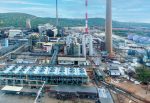Elevate Uranium has expanded its uranium footprint beyond the defined Koppies resource with mineralisation at Namib IV tenement outlined over an 11km by 7.5km area.
Systematic broad-spaced drilling at Namib IV prospect within the wider Koppies uranium project in Namibia has focused on further defining the extent of anomalism across the central project area.
Alongside this, Elevate Uranium has completed drilling of several early-stage, conceptual targets in the northwest, southwest and southeast extremities of the tenement, with the latter drilling phase completed last month.
So far, the approach through the central project area has been successful with the delineation of an extensive mineralised envelope of approximately 11km by 7.5km.
These programs identified calcrete-hosted mineralisation in areas of interpreted palaeochannel, typical of uranium deposits in the region.
Notably, the majority of uranium intersections at Namib IV are hosted within basement weathered granite, with some occurring in carbonate-veined schist.
A number of these intersections are well away from the interpreted palaeochannels and don’t align with the expected weathered basement beneath them, prompting further investigation into the uranium source and mineralisation controls.
Background on Namib IV
Namib IV is about 10 kilometres from the southern portion of the Koppies resource which comprises 66.1Mlbs of contained U3O8.
About 78% of that (43.6Mlbs) is in the higher confidence indicated category that provides enough geological certainty for mine planning.
Any resources delineated at Namib IV will add to the total Koppies resource base and could extend the potential life of mine or allow an increased production rate at any future mining operation at Koppies.
A total of 118 holes for 3,322 metres have been drilled and downhole gamma probed since the end of the March quarter.
EL8 is progressing Namib IV towards a maiden mineral resource, with the next steps to include additional step-out drilling to define the extent of the mineralisation, followed by infill drilling of selected areas to better define portions of higher-grade mineralisation.
This will then be drilled out at sufficient spacing to report the maiden resource.
Maiden resource by year end
EL8 managing director Murray Hill said while the current drilling phase is focused on determining the extent of mineralisation, future infill drill programs in selected areas will better define portions of higher-grade mineralisation, with a view to estimate a maiden mineral resource later in the year.
“Our exploration programs have diversified over the past 12 months to include a variety of targets in addition to the more traditional palaeochannel hosted style of mineralisation,” he said.
“We have identified mineralisation in basement lithologies at Koppies and Hirabeb, and now at Namib IV.
“These targets open a new search space for us, no longer restricting exploration to palaeochannel uranium deposits.”










